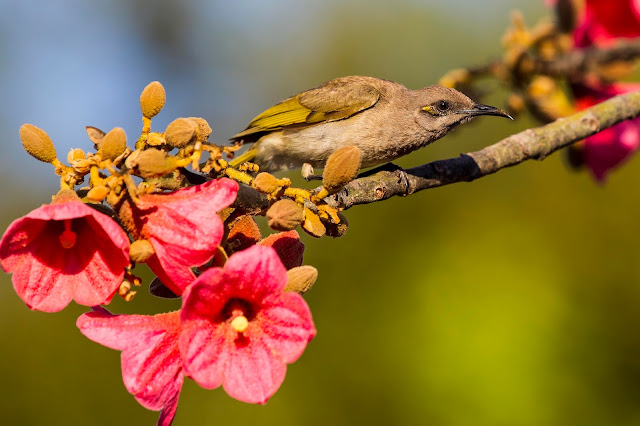Saturday, October 10, 2015
CAIRNS
We arrived at the Cairns Holiday Park late afternoon and after registering, immediately headed for the esplanade since high tide was approaching and evening light would be at my back, making it better for evening photography rather than early morning. It became readily apparent that the esplanade is a very popular place. It seemed to me that half the population of Europe and Japan was there along with the entire population of Cairns. People were grilling, jogging, bicycling, group exercising, exercising with personal trainers, and just enjoying the weekend. As I approached the esplanade edge, hoping to see thousands of shorebirds, I was met with a sign warning not to go over the wall onto the sand-so much for eye level shots. The wall, in fact was high enough to produce some pretty poor downward angles on close in birds. Suddenly I realized that I could not see a single shorebird. I scanned left, then right. Nothing. Out came the binoculars with almost the same results. Maybe a tiny group of white dots way to the right was shorebirds. We hurried to the possible flock, only to find a small group of Silver Gulls, Australia's common gull. In Michigan, the common gull is the Ring-billed Gull, occasionally called a "feathered rat" because of its liking for city dumps. Maybe Silver Gulls have more refined tastes than our common gull, but substituting Silver Gulls for a treasure trove of long-distance shorebird migrants was a disappointment. Too early in the season? Tide too high? Bad year for shorebirds. I didn't have a clue.
 |
| Silver Gull-Not what I had in mind |
Cairns Botanical Gardens
The next morning found us at the Cairns Botanical Gardens. This is one of the truly great tropical botanical gardens with free entry, free guided walks, a small restaurant, art and performance venues, along with rare plants from around the world. Everything is lush, colorful, and sometimes huge. If you want to see a plant with a single leaf measuring 7 meters across, this is the place. It can be confusing at times since it is divided into 4 distinct areas. The first is the Flekker Botanic Garden which was established in 1886 and therefore has tall and well established trees. This is the most cultivated and groomed section and probably deserves first look. For bird photography, you will deal with birds calling everywhere but seldom posing so you will have to work for them. A new addition (opened several days before we visited) was a phenomenal orchid house. A local, seeing me with my camera gear, was so animated he practically pushed me inside saying, "I can't believe how lucky we are having something like this in our backyard!" I had to agree with him.
 |
| With birds playing "hide from the photographer", these gardens almost make you want to switch from ornithology to botany. |
Adjoining the Flekker section and next to the Visitor Center is the "Tanks Art Centre". During WW II, three huge concrete storage tanks were built and camouflaged in the hillside to store fuel which was piped to the harbor below. These tanks supplied fuel for many Australian, American, British ships not only during the war but even up to 1987 before being decommissioned. Today the converted tanks host a full calendar of performance arts and other events for all of northern Queensland.
The Centenary Lakes section boast both a fresh and salt water lake, tropical rain forest boardwalk, grassy park with a Japanese tea house under construction. This area, being more open, will probably be the most productive for bird photographers.
The Mt Whitfield section offers a wilder experience as a forested mountain trek with spectacular views. There are two trail with the longest taking 5 hours.
After lunch I scouted two places north of Cairns, Yorkeys Knob and Catana Wetlands. Yorkeys Knob had a nice beach and pier but outside of some dolphins hunting fish near shore I did not believe it would produce many images. Catana Wetlands, however, looked very promising, and I planned on returning later.
Hurrying back to the esplanade, I found the same situation: lots of people and little to no shorebirds except whimbrels. There were several waders and pelicans mixed in with the gulls, so I settled on them while the occasional musician pounded away on the esplanade piano. Being serenaded while I photographed was a first for me.
 |
| Eastern Reef Egret (dark morph) |
 |
| Pied Imperial-Pigeons commute daily from offshore breeding islands to the mainland rainforest to feed on fruits |
 |
| Yellow Honeyeater |
 |
| Brown Honeyeater |









No comments:
Post a Comment